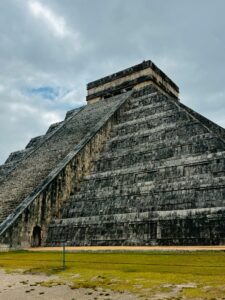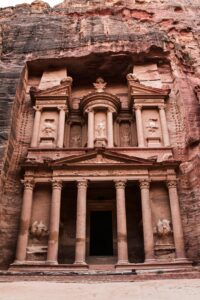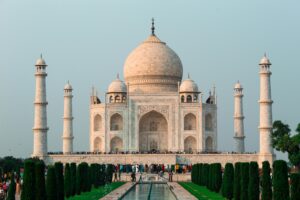Ever wondered what connects a 2,000-year-old gladiator arena with a mountain city hidden in the clouds for centuries? Seven monuments, scattered across continents, telling stories of human ambition that border on impossible.
These are the 7 Wonders of the World, architectural marvels that have captivated travelers, historians, and dreamers for generations. From the mathematical precision of the Great Pyramid to the romantic legend behind the Taj Mahal, each wonder reveals something profound about the civilization that created it.
I’ve spent the last decade documenting these magnificent structures, tracing their origins, and uncovering the lesser-known stories that textbooks skip over.
But here’s the question that keeps me up at night: why did these particular seven structures survive both physically and in our collective imagination, while countless others faded away?
1.The Ancient Wonder: Great Pyramid of Giza

The Great Pyramid of Giza, located on the Giza Plateau near Cairo, Egypt, is one of the most iconic and enduring symbols of Ancient Egypt and is the only surviving structure of the Seven Wonders of the Ancient World. Here are some key facts and insights about this monumental achievement:
Historical Context
- Construction Period: The Great Pyramid is believed to have been commissioned by the Pharaoh Khufu (also known as Cheops) during the Fourth Dynasty of the Old Kingdom, around 2580–2560 BC.
- Purpose: It served as a tomb for Pharaoh Khufu, reflecting the ancient Egyptians’ beliefs in the afterlife and the need for elaborate burial structures.
Architectural Features
- Size and Structure: Originally standing at 146.6 meters (481 feet), the Great Pyramid was the tallest man-made structure in the world for over 3,800 years. Over time, some of the outer casing stones have been removed, giving it a current height of about 138.8 meters (455 feet).
- Base: The base of the pyramid covers an area of approximately 13 acres and is made up of about 2.3 million blocks of stone, each weighing between 2.5 to 15 tons.
- Design: It is a true pyramid shape with a square base and four triangular sides that converge at the apex. The precise alignment of the pyramid’s corners is aligned almost perfectly with the cardinal points (north, south, east, west).
Construction Techniques
- Manpower: Estimates suggest that tens of thousands of workers, including skilled laborers, craftsmen, and seasonal workers, were involved in the construction. Contrary to popular belief, evidence indicates that they were not slaves but rather a well-fed labor force.
- Tools and Techniques: Ancient Egyptians used simple tools, such as copper chisels, and employed techniques like ramps to transport and place the massive stone blocks.
Cultural Significance
- Symbol of Power: The pyramid symbolizes the power and divine status of the pharaoh, showcasing the greatness of the Egyptian civilization.
- Religious Beliefs: The architecture reflects the ancient Egyptians’ complex beliefs about death and the afterlife, with the pyramid serving as a platform for Khufu’s soul to ascend to the heavens.
Legacy
- Tourist Attraction: Today, the Great Pyramid of Giza attracts millions of visitors each year and remains an essential subject of study for archaeologists and historians.
- Influence on Architecture: Its design has inspired countless structures throughout history and is a testament to the ingenuity and engineering skills of the ancient builders.
UNESCO World Heritage Site
In 1979, the Great Pyramid, along with the other pyramids of Giza, was designated a UNESCO World Heritage Site due to its cultural significance and historical value.
The Great Pyramid of Giza continues to be a source of fascination, symbolizing the remarkable achievements of ancient civilization and remaining a powerful testament to human ingenuity and ambition.
2. The Magnificent Colosseum: Rome’s Iconic Amphitheater

Architecture and Design
The Colosseum measures approximately 620 by 513 feet (189 by 156 meters) and stands about 157 feet (48 meters) high. Its elliptical shape allowed for a seating capacity of up to 80,000 spectators, who could enter and exit efficiently thanks to its well-designed system of gates and corridors. The structure is built from a combination of travertine stone, tuff, and brick, demonstrating the Romans’ skill in combining aesthetics and utility.
Gladiatorial Games and Events
The Colosseum was primarily used for gladiatorial contests and public spectacles, including animal hunts, mock sea battles, and executions. These events were not only a source of entertainment but also served as a means of political propaganda, showcasing the power and generosity of the emperors who organized them.
Cultural Significance
The Colosseum is not only a symbol of ancient Rome but also represents the cultural evolution of the empire. It reflects the social structures of the time, where the social elite enjoyed lavish seating while the lower classes were often seated in the upper tiers. The amphitheater also served as a venue for various events that reinforced Roman values and societal norms.
Preservation and Modern Day
Despite suffering damage from natural disasters, including earthquakes, and the ravages of time, the Colosseum remains remarkably well-preserved. It has undergone various restoration efforts over the years and attracts millions of visitors annually. Today, it stands as a UNESCO World Heritage site and serves as a reminder of Roman ingenuity and the complexities of its society.
Conclusion
The Colosseum continues to captivate people from all over the world. It is not just an architectural feat; it is a poignant symbol of the glory and brutality of ancient Rome. As one gazes upon its grand structure, the echoes of history resonate, reminding onlookers of a time when the Romans entertained, captivated, and united their populace within these formidable walls.
3. The Majestic Taj Mahal: A Monument to Eternal Love
The Taj Mahal, an exquisite symbol of eternal love, is one of the most celebrated monuments in the world. Located in Agra, India, it stands as a testament to the architectural brilliance of the Mughal era. Commissioned by Emperor Shah Jahan in memory of his beloved wife, Mumtaz Mahal, the Taj Mahal reflects a poignant story of love and loss.
Historical Context
Shah Jahan, the fifth Mughal emperor, reigned from 1628 to 1658. His love for Mumtaz Mahal, who died during childbirth in 1631, inspired the construction of this grand mausoleum. The monument’s construction began in 1632 and took approximately 22 years to complete, involving thousands of artisans and laborers.
Grandeur
The Taj Mahal is renowned for its stunning white marble façade, which changes color depending on the time of day, appearing pinkish in the morning, golden in the evening, and shimmering white under the moonlight. The monument features intricate carvings, detailed inlay work with semi-precious stones, and a symmetrical layout that epitomizes the principles of Mughal architecture.
Key features include:
- Main Dome: The large central dome rises to a height of about 35 meters and is surrounded by four smaller domes.
- Gardens: The Taj Mahal is set within a beautifully landscaped garden, following the Persian style of “Paradise Garden,” which symbolizes an earthly reflection of paradise.
- Reflecting Pool: A long reflecting pool in front of the Taj Mahal accentuates its beauty and provides a perfect mirror image of the monument.
- Minarets: Four majestic minarets frame the structure, each leaning slightly outward to create a visual effect that adds to the monument’s grandeur.
Cultural Significance
The Taj Mahal has stood the test of time, earning the status of a UNESCO World Heritage Site in 1983. It attracts millions of visitors each year and serves as an enduring symbol of love and devotion. Furthermore, it represents the heights of artistic and architectural achievement within the context of Mughal culture.
Preservation Challenges
Despite its glory, the Taj Mahal faces various challenges, including air pollution, which has led to discoloration of the marble. Restoration and preservation efforts are crucial to maintain its beauty for future generations.
Conclusion
The Majestic Taj Mahal is not merely an architectural masterpiece; it is a powerful emblem of love, loss, and the enduring nature of human emotions. Its beauty and historical significance make it a must-visit destination, leaving an indelible mark on the hearts of all who experience its splendor. Whether viewed at sunrise, sunset, or under the stars, the Taj Mahal continues to evoke feelings of awe and admiration, making it an eternal symbol of love.
4. Christ the Redeemer: Brazil’s Embracing Guardian

Christ the Redeemer: Brazil’s Embracing Guardian
Perched atop the Corcovado Mountain in Rio de Janeiro, the iconic statue of Christ the Redeemer stands as a symbol of faith, hope, and peace. Completed in 1931, this monumental work was designed by French sculptor Paul Landowski and built by Brazilian engineer Heitor da Silva Costa, with assistance from the French engineer Albert Caquot.
A Symbol of Connection
Christ the Redeemer, at 30 meters tall (98 feet), with arms extending 28 meters (92 feet) wide, is not only an impressive feat of engineering but also a significant cultural and religious symbol. Its outstretched arms embrace the city below, representing a welcoming gesture, inviting people of all backgrounds to come together. This embrace reflects the spirit of unity that characterizes Brazil, a nation known for its diversity and vibrant culture.
Historical Context
The statue was conceived as a way to foster a sense of community and national identity in Brazil during a time of political upheaval. The idea of constructing a large monument to represent Christianity emerged in the 1920s, amidst growing secularism. Funded by donations from the Brazilian population, the statue became a source of national pride and an enduring image of Rio de Janeiro.
Artistic and Architectural Significance
The statue is made of reinforced concrete and is covered in thousands of triangular soapstone tiles, which give it a smooth surface and a warm hue. Its design is a blend of Art Deco and Gothic styles, creating a visually striking form that complements the natural landscape of the surrounding Tijuca National Park. The breathtaking views from its vantage point also enhance its allure, making it a popular destination for tourists from across the globe.
Cultural Impact
Over the years, Christ the Redeemer has transcended its religious origins to become a universal emblem of compassion and understanding. It has been featured in countless films, documentaries, and works of art, and continues to inspire visitors who ascend its heights. It was declared one of the New Seven Wonders of the World in 2007, further cementing its status as an international icon.
Environmental and Social Initiatives
Beyond its artistic and religious significance, the statue has also played a role in social and environmental initiatives in Brazil. The surrounding Tijuca Forest is one of the largest urban rainforests in the world, and efforts to preserve this biodiversity are closely connected to the preservation of the monument. Christ the Redeemer stands not only as a guardian of faith but also as a guardian of nature, advocating for environmental awareness and action.
A Message for Humanity
As Christ the Redeemer gazes over Rio de Janeiro, its message of love and acceptance resonates with millions. In turbulent times, the statue serves as a reminder of our shared humanity and the importance of kindness and empathy in a fractured world. Visitors often leave with a renewed sense of hope and a desire to contribute to a more compassionate society.
In essence, Christ the Redeemer is not merely a statue; it is a powerful symbol of unity, strength, and love, embodying the spirit of Brazil and its people. As the embracing guardian of Rio de Janeiro, it invites individuals to reflect on their values and relationships, inspiring them to foster a world rooted in understanding and peace.
5. Chichen Itza: Unveiling Mayan Astronomical Genius

Chichen Itza, one of the most famous archaeological sites of the Maya civilization, is not only a stunning representation of Maya architecture and culture but also a testament to the advanced astronomical knowledge of the Maya people. Located in the Yucatán Peninsula of Mexico, this UNESCO World Heritage site has captivated scholars and tourists alike with its impressive structures and celestial alignments.
Key Features of Chichen Itza’s Astronomical Significance:
1. El Castillo (Temple of Kukulcán)
- The centerpiece of Chichen Itza, this step pyramid is dedicated to the serpent god Kukulcán. It stands 24 meters tall and features a total of 365 steps—one for each day of the solar year.
- During the equinoxes, the setting sun casts a serpent-like shadow down the pyramid’s stairway, creating the illusion of a snake slithering down to the ground. This phenomenon showcases the Maya’s understanding of solar cycles.
2. The Observatory (El Caracol)
- This circular structure is believed to have been used as an astronomical observatory. Its windows are strategically aligned with various celestial events.
- Archaeologists theorize that the Maya utilized this structure to track the movements of Venus and other celestial bodies, which played a significant role in their calendar and agricultural practices.
3. Ecliptic and Calendar Systems
- The Maya developed a complex calendar system that included the Tzolk’in (a 260-day calendar) and the Haab’ (a 365-day calendar). Their observations allowed them to accurately predict celestial events, agricultural cycles, and religious ceremonies.
- The site reflects the significance of the solar and lunar cycles in Maya society, influencing everything from farming to ritual practices.
4. Sacred Cenote
- The Cenote Sagrado, a natural sinkhole, was considered sacred and was used for religious ceremonies, including offerings to the rain god Chac. It was also influenced by astronomical events, as the Maya believed celestial bodies had a direct connection to water and agriculture.
Conclusion
Chichen Itza is a remarkable site that embodies the intersection of architecture, astronomy, and the ritualistic practices of the Maya civilization. The astronomical knowledge demonstrated through the site’s layout and structures highlights the sophistication of Maya science and their deep connection to the cosmos. As researchers continue to study these ancient insights, Chichen Itza remains a powerful symbol of the Maya people’s ingenuity and spiritual depth. The ongoing exploration of its astronomical significance helps preserve not just the history of a past civilization but also its lasting impact on our understanding of astronomy today.
6. Petra: The Rose-Red City Half as Old as Time

“Petra: The Rose-Red City Half as Old as Time” refers to the ancient city of Petra in Jordan, renowned for its stunning rock-cut architecture and water conduit system. Often referred to as the “Rose-Red City” because of the color of the stone from which it is carved, Petra was an important trading hub in ancient times and served as the capital of the Nabataean Kingdom.
The phrase “Half as Old as Time” suggests Petra’s long history, as it dates back to at least the 5th century BC, with its peak during the 1st century AD. Its impressive structures, including the Treasury (Al-Khazneh) and the Monastery (Ad-Deir), showcase the advanced engineering and artistry of the Nabataeans.
Petra is not only a UNESCO World Heritage Site but also one of the New Seven Wonders of the World, attracting thousands of visitors each year who come to marvel at its beauty and historical significance. If you have specific questions or require more information about Petra, feel free to ask!
7. The Great Wall of China: The Dragon’s Backbone
The Great Wall of China, often referred to as the “Dragon’s Backbone,” is an iconic symbol of China’s historical strength and resilience. Stretching over 13,000 miles, it is one of the most extensive construction projects in human history, built over several dynasties, with the earliest walls dating back to the 7th century BC.
Historical Background
The primary purpose of the Great Wall was to protect Chinese states and empires from invasions by nomadic groups from the north, particularly during the Qin (221-206 BC), Han (206 BC-220 AD), and Ming (1368-1644) dynasties. The wall also served as a means of border control, facilitating trade and immigration along the Silk Road.
Architectural Features
The Great Wall is not a single continuous wall but rather a series of walls and fortifications made from various materials, including earth, wood, bricks, and stone. It includes watchtowers, barracks, and signaling capabilities like smoke signals and fire beacons, allowing for efficient communication along its length.
Cultural Significance
The Great Wall has immense cultural and historical significance. It represents the ingenuity and perseverance of the Chinese people and has become a symbol of national pride. Today, it is recognized as a UNESCO World Heritage Site and attracts millions of visitors each year, offering insights into China’s rich history and architectural prowess.
Preservation Efforts
Over time, many sections of the Great Wall have suffered from erosion and neglect. Preservation efforts are ongoing, focusing on restoration while respecting its historical integrity.
Conclusion
The Great Wall of China, or the Dragon’s Backbone, is a monumental testament to the skill and determination of those who built it. It stands not only as a historical relic but also as a reminder of the rich cultural heritage of China, drawing fascination and admiration from around the world.
Conclusion
The Seven Wonders of the World
The Seven Wonders of the World—both the ancient and modern iterations—represent the pinnacle of human creativity, engineering, and aesthetic beauty. Each wonder tells a unique story, reflecting the values, cultures, and technological advancements of the societies that constructed them. From the majestic Great Wall of China to the architectural brilliance of the Taj Mahal, each site invites awe and admiration.
These wonders serve as reminders of our collective history, showcasing humanity’s ability to create monumental works amid various challenges, including political turmoil, natural disasters, and the passage of time. They encourage us to preserve and appreciate our cultural heritage while inspiring future generations to continue pushing the boundaries of innovation and artistry.
Visiting these sites is not only a journey through time but also an opportunity to understand and celebrate the diverse narratives that shape our world. In a globalized society where shared experiences are increasingly essential, the Seven Wonders stand as iconic symbols of our shared human experience and our enduring quest for beauty and greatness.








ret10s